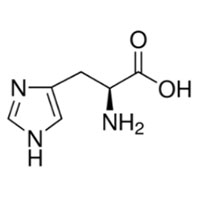



| N/A |
| Packing | |
|---|---|
| Storage | Powder -20°C 3 years 4°C 2 years;In solvent -80°C 6 months, -20°C 1 month |
| Shipping | Room temperature in continental US; may vary elsewhere |
Tel: 0086-25-52397805
Email: info@alchemist-chem.com

| Common Names | L-Histidine | ||
|---|---|---|---|
| Structure |  |
||
| CAS No. | 71-00-1 | Boiling Point (℃) | 458.9±35.0 °C at 760 mmHg |
| Molecular Weight | 155.16 | Melting Point (℃) | 282 °C (dec.)(lit.) |
| Density | 1.4±0.1 g/cm3 | Vapor Specific Gravity | N/A |
| Molecular Formula | C6H9N3O2 | Flash Point (℃) | 231.3±25.9 °C |
| Solubility | 41.6 g/L (25 ºC) | Autoignition Temperature (℃) | N/A |
| Personal Protective Equipment | Eyeshields;Gloves;type N95 (US);type P1 (EN143) respirator filter | ||
|---|---|---|---|
| Hazard Codes | T+:Very toxic | ||
| Safety Phrases | S1-S28-S45 | ||
| RIDADR | NONH for all modes of transport | ||
| WGK Germany | 3 | ||
| SYMPTOMS | PREVENTION | FIRST AID | |
| Inhalation | Cough. Sore throat. | Use local exhaust or breathing protection. | Fresh air, rest. |
| Skin | Redness. Burning sensation. Itching. | Protective gloves. | Remove contaminated clothes. Rinse and then wash skin with water and soap. |
| Eyes | Redness. Pain. | Wear safety goggles. | First rinse with plenty of water for several minutes (remove contact lenses if easily possible), then refer for medical attention. |
| Ingestion | Abdominal pain. Nausea. Vomiting. | Do not eat, drink, or smoke during work. Wash hands before eating. | Rinse mouth. Induce vomiting (ONLY IN CONSCIOUS PERSONS!). Refer for medical attention. |
| Description | L-Hisidine is an essential amino acid for infants. L-Hisidine is an inhibitor of mitochondrial glutamine transport. | ||
|---|---|---|---|
| Target | Km: 100-400 μM (amino acid transporter b0,+)[1] | ||
| In Vitro | L-histidine completely inhibits growth and its effect on viability is inversely related to FLO11 expression. L-histidine does not affect the viability of the Δflo11 and S288c strains. L-histidine dramatically decreases air-liquid biofilm formation and adhesion to polystyrene of the flor yeasts with no effect on the transcription level of the FLO11 gene. Moreover, L-histidine modifies the chitin and glycans content on the cell-wall of flor yeasts[1]. | ||
| References | [1]. Bou Zeidan M, et al. L-histidine inhibits biofilm formation and FLO11-associated
phenotypes in Saccharomyces cerevisiae flor yeasts. PLoS One. 2014 Nov 4;9(11):e112141. [2]. Rama Rao KV, et al. Brain edema in acute liver failure: inhibition by L-histidine. Am J Pathol. 2010 Mar;176(3):1400-8. [3]. Yoshikawa T, et al. Insufficient intake of L-histidine reduces brain histamine and causes anxiety-like behaviors in male mice. J Nutr. 2014 Oct;144(10):1637-41. |
||